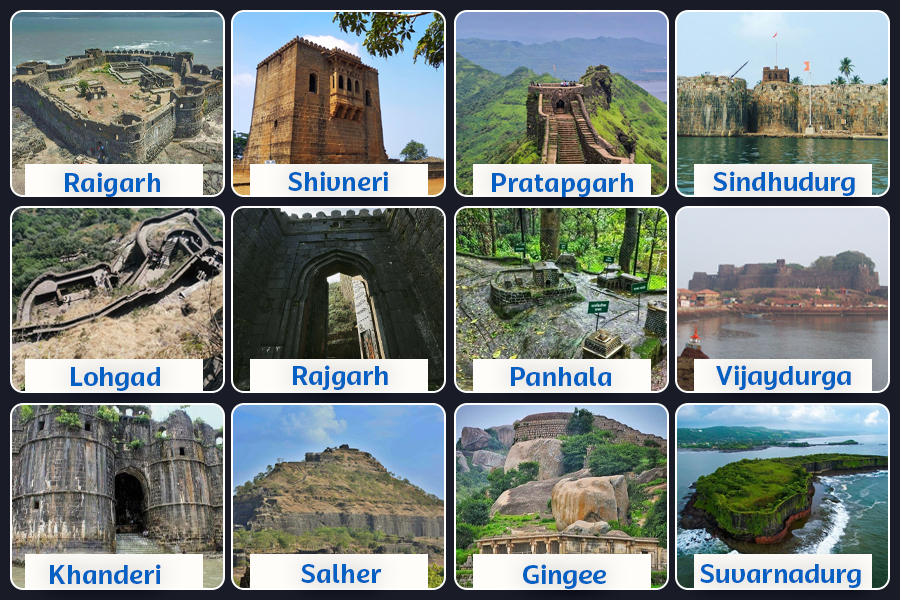India Achieves Milestone with 44 UNESCO World Heritage Sites as Maratha Military Landscapes Receive Global Recognition
Published : 07-Aug-2025 05:11:43 PM
India has solidified its position as a global heritage powerhouse with the recent inscription of the Maratha Military Landscapes as its 44th UNESCO World Heritage Site, reinforcing the nation's commitment to preserving its rich cultural and natural heritage for future generations. The historic announcement was made during the 47th Session of the World Heritage Committee in Paris, where India's official nomination, Maratha Military Landscapes of India, was inscribed on the UNESCO World Heritage List, becoming the country's 44th property to receive this global distinction.
India's impressive collection of UNESCO World Heritage Sites encompasses 36 cultural sites in India, seven natural heritage locations across the country, and one mixed heritage property, demonstrating its diverse architectural brilliance and ecological significance. This achievement places India sixth globally and second in the Asia-Pacific region for the highest number of World Heritage Sites, underscoring its exceptional contribution to world heritage preservation.
The journey began in 1983 when India's first UNESCO World Heritage Sites were inscribed, marking the beginning of a remarkable heritage conservation legacy. Since then, the world heritage sites list for India has steadily expanded, celebrating both ancient monuments and natural wonders that showcase the nation's multifaceted heritage.
The inscribed Maratha landscape includes twelve major fortifications, mostly in the state of Maharashtra, with one in Tamil Nadu. These forts were built, adapted, or expanded by the Marathas between the late 17th and early 19th centuries. The Maratha Military Landscapes represent an extraordinary network of strategic fortifications that demonstrate the military vision and architectural ingenuity of the Maratha Empire under Chattrapati Shivaji Maharaj. The twelve components of this UNESCO monument include historically significant forts such as Raigad, Shivneri, Pratapgad, Sindhudurg, Suvarnadurg, Lohgad, Rajgad, Panhala Fort, Vijay Durg, Khanderi Fort, Salher Fort, and Gingee Fort in Tamil Nadu. These Indian heritages span from the 17th to 19th centuries CE and exemplify innovative military architecture adapted to diverse geographical terrains.

The addition of the Maratha Military Landscapes follows the 2024 inscription of the Moidams of Charaideo, Assam, which became India's 43rd UNESCO World Heritage Site. The Moidams represent the burial traditions of the Ahom dynasty and reflect the cultural significance of Assam's historical legacy.
Looking ahead, India has submitted a comprehensive dossier titled "Ancient Buddhist Site, Sarnath" to the UNESCO World Heritage Centre for the 2025-26 nomination cycle. This nomination represents India's continued efforts to showcase its Buddhist heritage sites and spiritual significance on the global stage. The nomination process typically requires approximately 1.5 years from submission to final decision, following strict operational guidelines established by UNESCO.
India maintains an extensive Tentative List comprising 62 sites, which serves as a mandatory prerequisite for future World Heritage Site nominations. This strategic approach ensures systematic evaluation and preparation of potential heritage properties. Under UNESCO regulations, each state party may propose only one site annually for consideration by the World Heritage Committee. Furthermore, the diversity of India's UNESCO World Heritage Sites includes architectural marvels like the Taj Mahal, ancient cave complexes such as Ajanta and Ellora Caves, magnificent temples including the Sun Temple at Konark, and natural wonders like the Sundarbans National Park. These sites represent various historical periods and cultural traditions, from Buddhist monuments to Mughal architecture, from ancient rock-cut caves to colonial heritage.
The List of 44 UNESCO World Heritage Sites in India
|
S. No. |
Site |
Location (state) |
Date |
|---|---|---|---|
|
1 |
Ajanta Caves |
Maharashtra |
1983 |
|
2 |
Ellora Caves |
Maharashtra |
1983 |
|
3 |
Agra Fort |
Uttar Pradesh |
1983 |
|
4 |
Taj Mahal |
Uttar Pradesh |
1983 |
|
5 |
Sun Temple, Konârak |
Odisha |
1984 |
|
6 |
Group of Monuments at Mahabalipuram |
Tamil Nadu |
1984 |
|
7 |
Kaziranga National Park |
Assam |
1985 |
|
8 |
Manas Wildlife Sanctuary |
Assam |
1985 |
|
9 |
Keoladeo National Park |
Rajasthan |
1985 |
|
10 |
Churches and Convents of Goa |
Goa |
1986 |
|
11 |
Khajuraho Group of Monuments |
Madhya Pradesh |
1986 |
|
12 |
Group of Monuments at Hampi |
Karnataka |
1986 |
|
13 |
Fatehpur Sikri |
Uttar Pradesh |
1986 |
|
14 |
Group of Monuments at Pattadakal |
Karnataka |
1987 |
|
15 |
Elephanta Caves |
Maharashtra |
1987 |
|
16 |
Great Living Chola Temples |
Tamil Nadu |
1987 |
|
17 |
Sundarbans National Park |
West Bengal |
1987 |
|
18 |
Nanda Devi and Valley of Flowers National Parks |
Uttarakhand |
1988 |
|
19 |
Buddhist Monuments at Sanchi |
Madhya Pradesh |
1989 |
|
20 |
Humayun's Tomb, Delhi |
Delhi |
1993 |
|
21 |
Qutb Minar and its Monuments, Delhi |
Delhi |
1993 |
|
22 |
Mountain Railways of India |
West Bengal, Tamil Nadu, Himachal Pradesh |
1999 |
|
23 |
Mahabodhi Temple Complex at Bodh Gaya |
Bihar |
2002 |
|
24 |
Rock Shelters of Bhimbetka |
Madhya Pradesh |
2003 |
|
25 |
Chhatrapati Shivaji Terminus (formerly Victoria Terminus) |
Maharashtra |
2004 |
|
26 |
Champaner-Pavagadh Archaeological Park |
Gujarat |
2004 |
|
27 |
Red Fort Complex |
Delhi |
2007 |
|
28 |
The Jantar Mantar, Jaipur |
Rajasthan |
2010 |
|
29 |
Western Ghats |
Maharashtra, Karnataka, Kerala, Tamil Nadu |
2012 |
|
30 |
Hill Forts of Rajasthan |
Rajasthan |
2013 |
|
31 |
Rani-ki-Vav at Patan, Gujarat |
Gujarat |
2014 |
|
32 |
Great Himalayan National Park Conservation Area |
Himachal Pradesh |
2014 |
|
33 |
Nalanda Mahavihara at Nalanda, Bihar |
Bihar |
2016 |
|
34 |
Khangchendzonga National Park |
Sikkim |
2016 |
|
35 |
The Architectural Work of Le Corbusier |
Chandigarh |
2016 |
|
36 |
Ahmadabad |
Gujarat |
2017 |
|
37 |
Victorian Gothic and Art Deco Ensembles of Mumbai |
Maharashtra |
2018 |
|
38 |
Jaipur City |
Rajasthan |
2019 |
|
39 |
Kakatiya Rudreshwara (Ramappa) Temple, Telangana |
Telangana |
2021 |
|
40 |
Dholavira: a Harappan City |
Gujarat |
2021 |
|
41 |
Santiniketan |
West Bengal |
2023 |
|
42 |
Sacred Ensembles of the Hoysalas |
Karnataka |
2023 |
|
43 |
Moidams-the Mound-Burial System of the Ahom Dynasty |
Assam |
2024 |
|
44 |
Maratha Military Landscapes of India |
Maharashtra |
2025 |
The recognition of these cultural sites in India and natural heritage locations by UNESCO serves multiple purposes: preservation of outstanding universal value, promotion of heritage tourism, and educational advancement. These UNESCO monuments attract millions of visitors annually, contributing significantly to India's cultural economy while fostering international appreciation for Indian heritage places. The World Heritage designation also brings international cooperation in conservation efforts, technical expertise sharing, and funding opportunities for maintenance and restoration projects. This global recognition ensures that future generations can experience and learn from these remarkable testimonies to human creativity and natural beauty.
India's achievement of 44 UNESCO World Heritage Sites represents not merely a numerical milestone but a testament to the nation's rich tapestry of cultural diversity, historical continuity, and environmental stewardship. As India continues to nominate additional sites for UNESCO recognition, the country reinforces its position as a custodian of world heritage, balancing preservation with accessibility and education.
Get in Touch
Have An Enquiry? Write To Us…
Related Packages
Information Links and Downloads
Related Blogs

We Got Featured in the Media
Stay Connected for All Updates!
For the latest updates on Kailash Mansarovar Yatra, Adi Kailash Yatra
and other incredible travel destinations, make sure you’re following our channel

 WhatsApp
WhatsApp Instagram
Instagram























